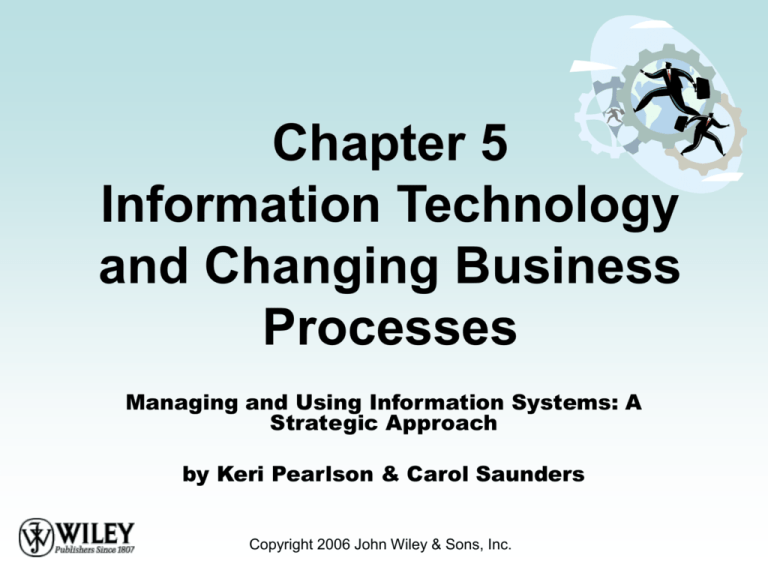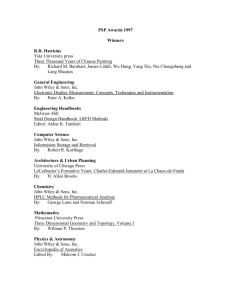
Chapter 5
Information Technology
and Changing Business
Processes
Managing and Using Information Systems: A
Strategic Approach
by Keri Pearlson & Carol Saunders
Copyright 2006 John Wiley & Sons, Inc.
Introduction
• How can IT enable business change?
– Think of several examples.
• How can IT impede business change?
• What problems are caused by the
functional (silo) perspective of a business?
• The process perspective keeps the big
picture in view. How can IT help with this
management style?
• How are TQM and BPR used to transform
a business?
Copyright 2006 John Wiley & Sons, Inc.
Real World Examples
• Cigna needed to radically improve operational efficiency due to the
following factors.
– Income had fallen 11%.
– Exceeded market costs of other companies.
– Sagging productivity in crucial areas.
• IT investments were not supporting the strategic direction of the
company and sophisticated new applications were being layered on
top of existing organizations and processes.
• Cigna decided to initiate a program to radically redesign the company’s
operating processes in key areas.
• Successes were replicated to other areas and the company realized
savings of more than $100 million from more than 20 reengineering
initiatives.
–
–
–
–
Operating expenses reduced by up to 42%.
Cycle time improvements of 100%
Customer satisfaction increased 50%
Quality improvements of 75%
Copyright 2006 John Wiley & Sons, Inc.
SILO PERSPECTIVE
VERSES
BUSINESS PROCESS
PERSPECTIVE
Copyright 2006 John Wiley & Sons, Inc.
Silo (Functional) Perspective
• The silo perspective views the business as
discrete functions (accounting, sales, production,
etc.). Figure 5.1 shows a traditional org chart
which is how a functional business is organized.
• Each functional area determines its core
competencies and focuses on what it does best.
• Advantages:
– Allows optimization of expertise.
– Group like functions together for learning.
• Disadvantages:
– Significant sub-optimization.
– Tend to lose sight of overall organizational objectives.
Copyright 2006 John Wiley & Sons, Inc.
Figure 5.1 Hierarchical Structure
Copyright 2006 John Wiley & Sons, Inc.
Process Perspective
• Keeps the big picture in view.
• Focuses on work being done to create optimal
value for the business.
• Advantages:
– Helps avoid or reduce duplicate work.
– Facilitate cross-functional communication.
– Optimize business processes.
• Figure 5.2 shows a typical procurement process.
• Figure 5.3 shows the cross-functional view of
processes as they cross departments
(functions).
Copyright 2006 John Wiley & Sons, Inc.
Figure 5.2 – Sample business process
Copyright 2006 John Wiley & Sons, Inc.
Figure 5.3 Cross-functional nature of business processes
Copyright 2006 John Wiley & Sons, Inc.
Process Perspective (continued)
• When managers gain the process perspective
they begin to lead their organizations to change.
• Question status quo.
• Don’t accept “because we have always done it
that way” as an answer to why business is done in
a particular way.
• Allows managers to analyze business’s processes
in light of larger goals.
• Figure 5.4 summarizes the silo and process
views.
Copyright 2006 John Wiley & Sons, Inc.
Silo Perspective
Business Process
Perspective
Definition
Self-contained functional units
such as marketing, operations,
finance, and so on
Interrelated, sequential set
of activities and tasks that
turns inputs into outputs
Focus
Functional
Cross-functional
Goal
Accomplishment
Optimizes on functional goals,
which might be a suboptimal
organizational goal.
Optimizes on organizational
goals, or “big picture”
Benefits
Highlighting and developing core
competencies; Functional
efficiencies
Avoiding work duplication
and cross-functional
communication gaps;
organizational effectiveness
Figure 5.4 Comparison of Silo Perspective and
Business Process Perspective
Copyright 2006 John Wiley & Sons, Inc.
THE TOOLS FOR CHANGE
Copyright 2006 John Wiley & Sons, Inc.
TQM
• Total Quality Management (TQM) is a tool
for change that uses small incremental
changes.
• Personnel often react favorably to TQM.
• Greater personnel control and ownership.
• Change is viewed as less of a threat.
• Six-Sigma is one popular approach to
TQM
Copyright 2006 John Wiley & Sons, Inc.
BPR
• Business Process Reengineering (BPR) is a
more “radical” change management tool.
• Attain aggressive improvement goals.
• Goal is to make a rapid, breakthrough impact on
key metrics.
• Figure 5.6 shows the difference over time of the
radical (BPR) and incremental (TQM)
approaches to change.
• Greater resistance by personnel.
• Use only when radical change is needed.
Copyright 2006 John Wiley & Sons, Inc.
Figure 5.5 Comparison of radical and incremental improvement
Copyright 2006 John Wiley & Sons, Inc.
The Process for Radical Redesign
• The different approaches for radical redesign all
include:
– Begin with a vision of which performance metrics best
reflect the success of overall business strategy.
– Make changes to the existing process.
– Measure the results using the predetermined metrics.
• Figure 5.6 illustrates a general view of radical
design.
• Figure 5.7 illustrates a method for redesigning a
business process.
• Tool used to understand a business process is a
workflow diagram.
Copyright 2006 John Wiley & Sons, Inc.
Figure 5.6 – Conceptual flow of process design
Copyright 2006 John Wiley & Sons, Inc.
Figure 5.7 – Method for redesigning a business process
Copyright 2006 John Wiley & Sons, Inc.
Risks of Radical Redesign
• Difficult to manage the process.
– Manager needs a strong set of skills.
•
•
•
•
Insuring acceptance of the new process.
Transformation champion needed.
Clear and well thought out plan.
Risk of failure of the new process.
Copyright 2006 John Wiley & Sons, Inc.
INTEGRATED
SUPPLY CHAINS
Copyright 2006 John Wiley & Sons, Inc.
Integrated Supply Chains
• Processes linked across companies.
• Supply chain begins with raw materials
and ends with a product/service.
• Globalization of business and ubiquity of
communication networks permits use of
suppliers from anywhere.
• Requires coordination among partners of
the integrated supply chain.
Copyright 2006 John Wiley & Sons, Inc.
Integrated Supply Chain (continued)
• Challenges include:
– Information integration.
– Synchronized planning.
– Workflow coordination.
• Leads to new business models.
– For example when banks link up to
businesses new financial services are offered
such as on-line payments.
– Companies list needs and vendors
electronically bid to be the supplier.
Copyright 2006 John Wiley & Sons, Inc.
ENTERPRISE SYSTEMS
Copyright 2006 John Wiley & Sons, Inc.
Enterprise Systems
• A set of information systems tools used to
enable information flow within and between
processes.
• Enterprise systems are comprehensive software
packages.
• ERP (Enterprise Resource Planning) software
packages are the most frequently discussed
type of enterprise system.
• Designed to manage the potentially hundreds of
systems throughout a large organization.
• SAP is the most widely used ERP software
package.
Copyright 2006 John Wiley & Sons, Inc.
Characteristics of Enterprise
Systems
• Integration – seamlessly integrate information
flows throughout the company.
• Packages – they are commercial packages
purchased from software vendors (like SAP,
Oracle, Peoplesoft, etc.).
• Best practices – reflect industry best practices.
• Some assembly required – the systems need to
be integrated with the existing hardware, OS’s,
databases, and telecommunications.
• Evolving – the systems continue to change to fit
the needs of the diverse marketplace.
Copyright 2006 John Wiley & Sons, Inc.
Benefits and Disadvantages of
Enterprise Systems
• Benefits:
– All modules easily communicate together.
– Useful tools for centralizing operations and decision
making.
– Can reinforce the use of standard procedures.
• Disadvantages:
– Implementation is an enormous amount of work.
– Most require some level of redesigning business
processes.
– Hefty price tag (sold as a suite).
– They are risky.
Copyright 2006 John Wiley & Sons, Inc.
The Adoption Decision
• Sometimes it is appropriate to let the enterprise
system drive business process redesign.
– When just starting out.
– When organizational processes not relied upon for
strategic advantage.
– When current systems are in crisis.
• Sometimes it is inappropriate to let the
enterprise system drive business process
redesign.
– When changing an organizations processes that are
relied upon for strategic advantage.
– When the package does not fit the organization.
– When there is a lack of top management support.
Copyright 2006 John Wiley & Sons, Inc.
FOOD FOR THOUGHT:
THE RISKS OF RADICAL
REDESIGN ALONE
Copyright 2006 John Wiley & Sons, Inc.
Risks of Radical Redesign
• Research shows some of the common reasons
why companies fail to reach their goals:
–
–
–
–
–
Lack of senior management support.
Lack of coherent communications.
Introducing unnecessary complexity.
Underestimating the amount of effort needed.
Combining reengineering with downsizing.
• Hammer argues that radical redesign is often
distorted in one of five ways as listed on page 519.
Copyright 2006 John Wiley & Sons, Inc.
SUMMARY
Copyright 2006 John Wiley & Sons, Inc.
Summary
• IS can enable or impede business change.
• You must look at business process to
understand the rule IS plays in business
transformation.
• TQM or BRP are normally used to make
changes to business processes.
• ERP systems can be used to affect
organizational transformation.
• Information systems are useful tools to both
enable and manage business transformation.
Copyright 2006 John Wiley & Sons, Inc.
• Copyright 2006 John Wiley & Sons, Inc.
•
All rights reserved. Reproduction or translation of this work beyond that
named in Section 117 of the 1976 United States Copyright Act without the
express written consent of the copyright owner is unlawful. Request for
further information should be addressed to the Permissions Department,
John Wiley & Sons, Inc. The purchaser may make back-up copies for
his/her own use only and not for distribution or resale. The Publisher
assumes no responsibility for errors, omissions, or damages, caused by the
use of these programs or from the use of the information contained herein
Copyright 2006 John Wiley & Sons, Inc.







